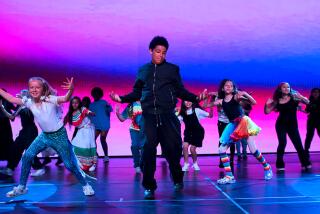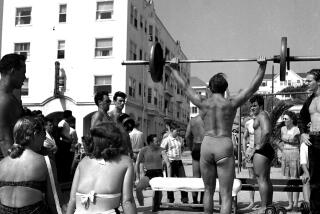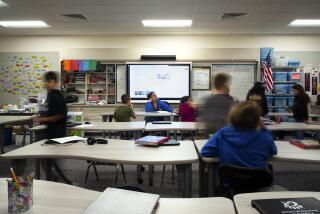Gym class, revisited
Independence, Ore. — The third-grade students in Meg Greiner’s PE class at Independence Elementary School can barely contain themselves as they wait for the previous class to end. With limbs twitching in anticipation, eyes fixed on the gymnasium and the equipment inside, they bound into the room as if being set free in a theme park.
“Miss Greiner?” they wail. “Can we use the unicycles? Can we climb the rock wall today? Pleeeeaaaaase??”
Their enthusiasm suggests a much different experience from that which many of the students’ parents may remember from their days in gym class. No more agonizing rope climbs. No more anxiety and dread, wondering if they’d be picked last for softball or pummeled mercilessly in dodge ball.
Physical education in kindergarten through high school is going through an evolution, with conventional activities such as team sports and lap-running taking second place to in-line skating, snowshoeing and circus classes that emphasize fun, continual movement and individual skills instead of team competition. No more standing around waiting for a turn at the ball.
Around the country, kids have access to more than ball sports. At Tucson High School, students have their pick of health club equipment, from treadmills to elliptical trainers. At the private Kamehameha School in Hawaii, the curriculum includes everything from fencing to Frisbee golf. And in Florida, one elementary school has introduced juggling.
Educators are also focusing on why it’s important to exercise. Students are taught about cardiovascular health, how to maintain a target heart rate and the importance of strength training and good nutrition. The goal of these new programs: to instill in children a lifelong love of exercise.
Not all schools are following this game plan. Many cash-strapped school districts have cut physical education entirely, or maintain bare-bones programs that lack the funds for stair climbers or unicycles. Others don’t see the need to radically alter PE programs that are little different from those of 20 or 30 years ago.
Increasingly, though, the idea of physical education that starts children on the path toward a lifelong involvement with exercise and health is gaining momentum in the nation’s schools. Administrators and educators are concerned about rising obesity rates among children, causing them to rethink everything from vending machines to recess. And today’s PE teachers may be motivated to make gym class more enjoyable than the lap-around-the-track and rope-climbing drills they experienced as children.
“We don’t want to eliminate team sports,” says Anne Flannery, president of P.E.4LIFE, a Missouri-based nonprofit group that promotes physical education. “But those need to be balanced with health and wellness experiences, and learning, so the kids find what they love to do and are physically active their whole lives.”
Independence Elementary’s 350 students meet at 8:30 a.m. in the gym for 20 minutes of stretching, moderate exercise (arm circles, knee lifts) and choreographed dance, all done to a variety of music that includes calypso tunes and hip-hop. “It gets the body and brain ready to go,” says Greiner, 40, who conducts the session standing atop a table. The students’ classroom teachers and a smattering of parents join in.
Many of the parents taking part in the TEAM (Together Everyone Achieves More) Time program are big fans of Greiner’s class. Says Terry Alvarez, who has a son in second grade and a daughter in kindergarten: “I don’t remember learning much in PE, but my daughter comes home and tells me what the chambers in the heart are, and what exercise will do for your heart.”
The importance of exercise is stressed every day, says Maria Blanco, who has daughters in kindergarten and third grade. “They learn that it’s not only important physically but mentally. It’s the idea that we’re helping our brains with what we’re doing.”
Teachers see the benefits too. Says Holly Sims, who teaches first and second grades, “When I taught in other schools in the mornings it would be, ‘OK, wake up, everybody, let’s get going.’ Here, they’re awake and ready to learn.”
Nine half-hour periods of PE follow TEAM Time (children have PE four days a week for a half-hour a day). As some 25 fourth-grade students race into the gym, they grab pedometers and quickly clip them onto their waistbands. The pedometers, purchased recently with grant funds, help Greiner determine whether the kids are moving enough during class. She leads them in a quick game of tag, after which she has them check their pedometers. Uniforms are not required, just tennis shoes. On this day, no students are reluctant participants.
Placed around the room are cards that direct students to do strength-building moves, such as sit-ups or wall push-ups; cardio exercises, such as the dancelike grapevine; and stretches for flexibility. After several minutes of this, students pause to check their heart rates, and then it’s time to ride unicycles.
Some take off like circus pros, while others pedal haltingly, supported by a classmate on either side. They wobble and teeter, falling occasionally but quickly springing up. “I’m used to it,” says one girl after taking a spill.
“A lot of kids are not risk-takers,” Greiner explains. “You have to set up an atmosphere where it’s safe to take risks.”
By the end of class, some students have logged more than 1,000 steps. Their breathing is audible, and beads of sweat cover their faces.
PE classes throughout the day are structured similarly. In some classes, students use stability balls and stability pads to practice balance. Juggling teaches hand-eye coordination, and wall climbing emphasizes risk-taking, balance and strength. The climbing wall, constructed of wood with hand- and footholds, took about two years to construct, with help from some parents.
“Equipment is huge,” says Greiner during a break. “It’s more of a novelty, but when you have it, kids are apt to do more and they get excited about PE. The brain gets hooked.”
The rock wall is 10-year-old Vanessa Mendoza’s favorite thing to do. “It’s fun because we get to play, and sometimes it makes me sweat.”
During class Greiner quizzes the students on their exercise knowledge.
“Cardiovascular endurance ... ,” Greiner begins.
“Helps my heart!” the kids shout.
During a leg stretch, kindergartners are asked what muscle is being used.
“Hamstring!” they reply.
“My philosophy,” says Greiner, “is to teach them skills, not a sport. Then, if they want to go further, they can. But I give them the foundation to go out and try things. The stuff we’re doing now are things they can incorporate forever.”
Independence is a small, rural town about 20 minutes outside Salem, where the main street features an old-fashioned lunch counter. Greiner estimates that roughly 15% of the school’s students are overweight or obese, about the same as the national average.
Greiner supplements her next-to-nothing budget (about $200 a year) with grants and donations from the local Parent Teacher Organization and local businesses.
Schools and teachers who work to keep PE in the curriculum have support from industry organizations geared to promoting physical activity, such as the American Alliance for Health, Physical Education, Recreation and Dance, and the National Assn. for Sport and Physical Education. The PE Central website (www.pecentral.org) provides information for teachers, parents and students, such as inventive lesson plans. It averages about 90,000 hits a month. The Carol M. White Physical Education Program grants, passed by Congress in 2000, have been a boon to schools. These federal PEP grants were developed to support innovative PE programs that establish lifelong healthy habits. This year, 1,500 applications have been submitted, and $69.6 million will be doled out.
Other schools around the country that are adding innovative programs include Montebello Intermediate School in Montebello, which obtained grants that allowed it to set up a fitness lab with elliptical trainers, stationary bikes, treadmills, stair climbers and weight machines. Other programs include an obstacle course that promotes problem-solving and cooperation.
“We got too competitive and sports-oriented,” says Karen Mendon, one of five PE teachers at the school. “This is a well-rounded program that teaches the kids why it’s important to exercise. There is a place for competitive sports, but not everyone wants to be competitive.”
In Arizona, the PE program at Tucson High School incorporates strength and cardio equipment, and includes yoga, cycling and urban hiking, as well as traditional offerings, such as volleyball. “We’re trying a bunch of things to try and grab kids,” says Gary Lewis, recently named high school physical education teacher of the year by the National Assn. for Sport and Physical Education. “You have to keep it interesting. It doesn’t matter how you get kids active, as long as you get them moving. The bottom line is, we’re trying to create something that’s fun so they don’t really know they’re sweating.”
At Kamehameha School in Maui, Hawaii, PE teacher Kelly Duell’s program features an intense jump-rope course, dance, fencing, croquet, Frisbee golf and orienteering, or learning to traverse the landscape. In Boca Raton, Fla., at Verde Elementary School, PE teacher James Gostomski has integrated juggling and a nonsedentary form of fishing into his curriculum.
Undergraduate and graduate exercise science and kinesiology programs are catching up with changing trends, according to George Graham, professor of kinesiology at Penn State University. “I think we’re better at preparing people to teach well,” he says. “We know now that it’s important to keep kids active for the majority of the lesson, and that it’s bad to have lines and waiting time. And I’d like to say that having captains pick teams is a thing of the past.”
Graham is frustrated, however, by the lack of research tracking children in innovative PE programs. Such research would evaluate the effectiveness of these programs in developing a long-term interest and dedication to fitness. “It’s difficult research to do, and expensive.”
At Independence Elementary, Greiner heads into her office to show off her latest tool -- iPAQ personal PCs to help students keep track of their progress and assess their fitness levels. She hopes more schools will adopt programs like TEAM Time. “They’re moving in that direction because I keep pushing.”
*
(BEGIN TEXT OF INFOBOX)
Grading gym class
What should parents look
for when evaluating the quality of a school’s physical education classes? Charlene Burgeson, executive director of the National Assn. for Sport & Physical Education, offers these tips:
Is the teacher well qualified? Classes should be taught by a state-certified physical education teacher, not a teacher who has little or no background in PE.
How much time do the kids spend in gym class? National guidelines recommend at least 30 minutes per day for elementary school students and 45 minutes daily for middle- and high-school students. Classes should be structured; they should not be a glorified recess.
Does the PE class emphasize team sports or other types of activities? Team sports are fine for older kids but tend to allow little time for each student to participate. They’re not always appropriate for younger elementary-school students. Regardless of age, groups should be small so students get as much physical activity as possible.
Do children have different activities from which to choose? Children should be given a variety of activities to develop a range of skills -- in their daily classes as well as throughout the school year.
After describing to students what their class activities will be, what does the teacher do? An instructor should move among the students, offering constructive advice and monitoring students’ progress, not just watch from the sidelines. Children should be taught how exercise affects the body, so they understand why it’s important to keep fit throughout their lives.
More to Read
Sign up for Essential California
The most important California stories and recommendations in your inbox every morning.
You may occasionally receive promotional content from the Los Angeles Times.










